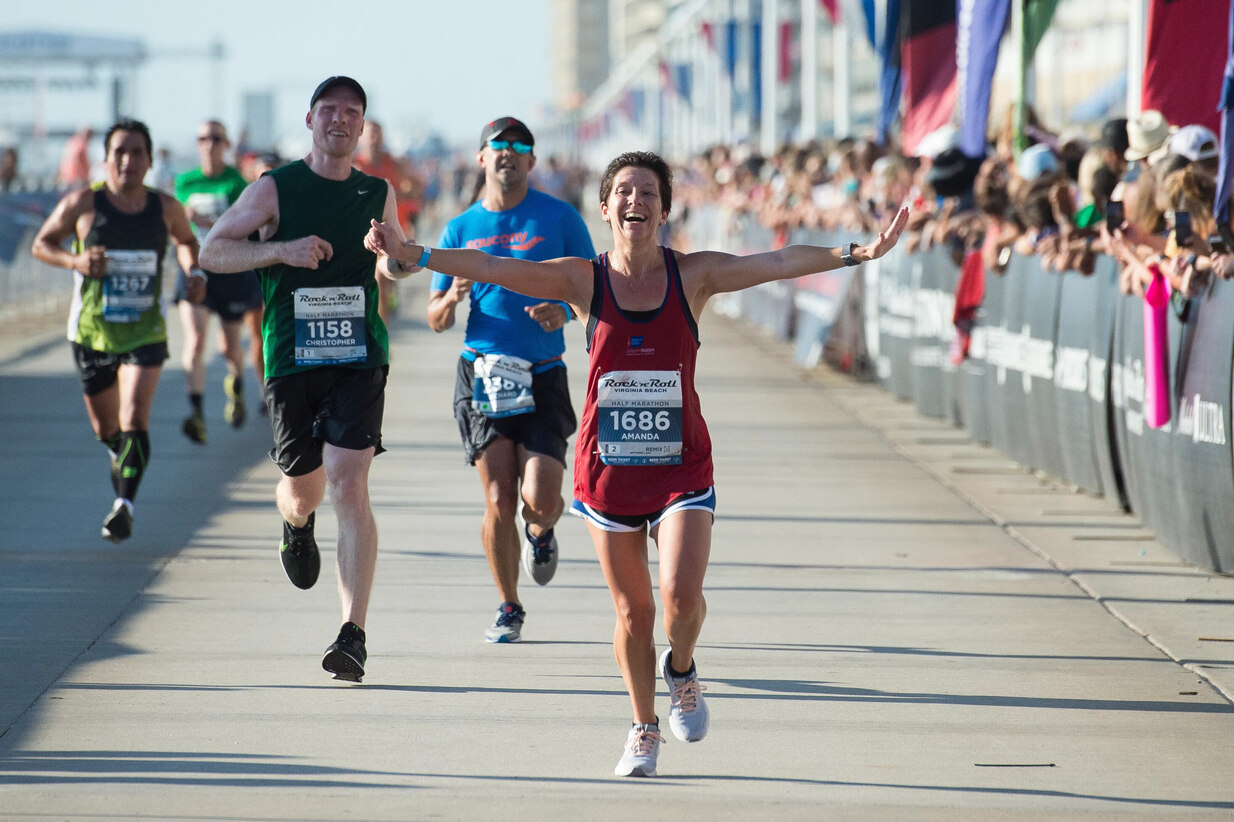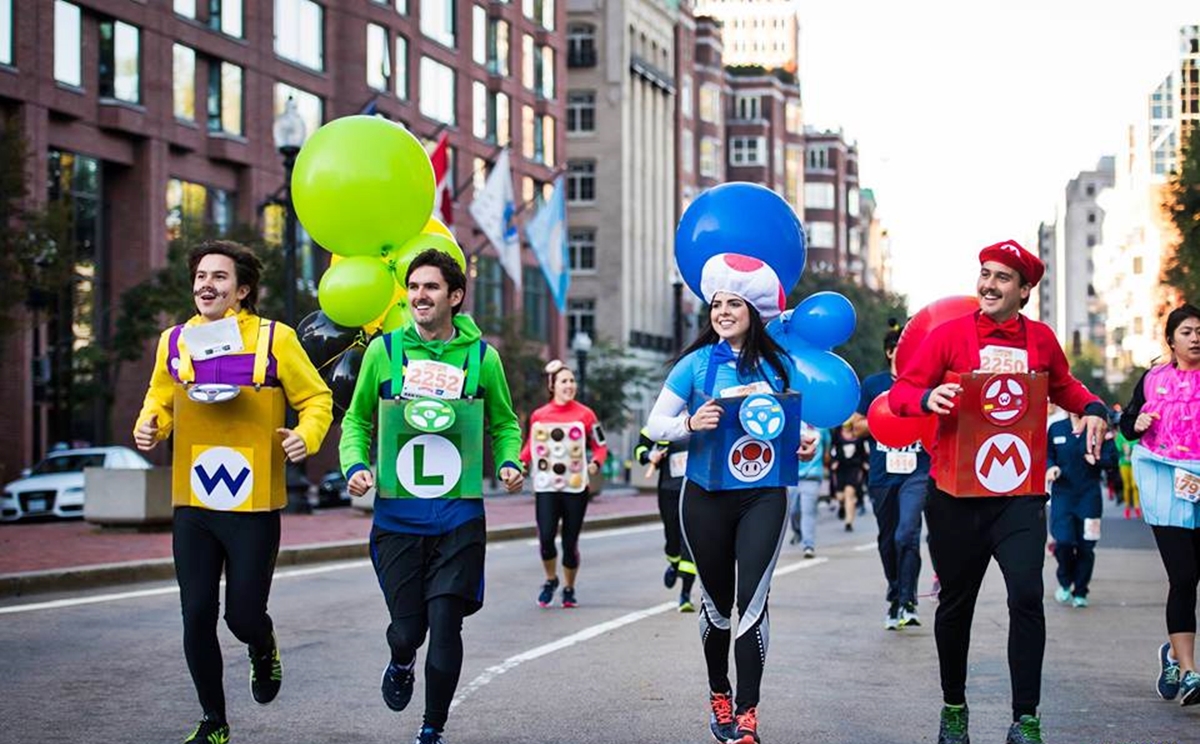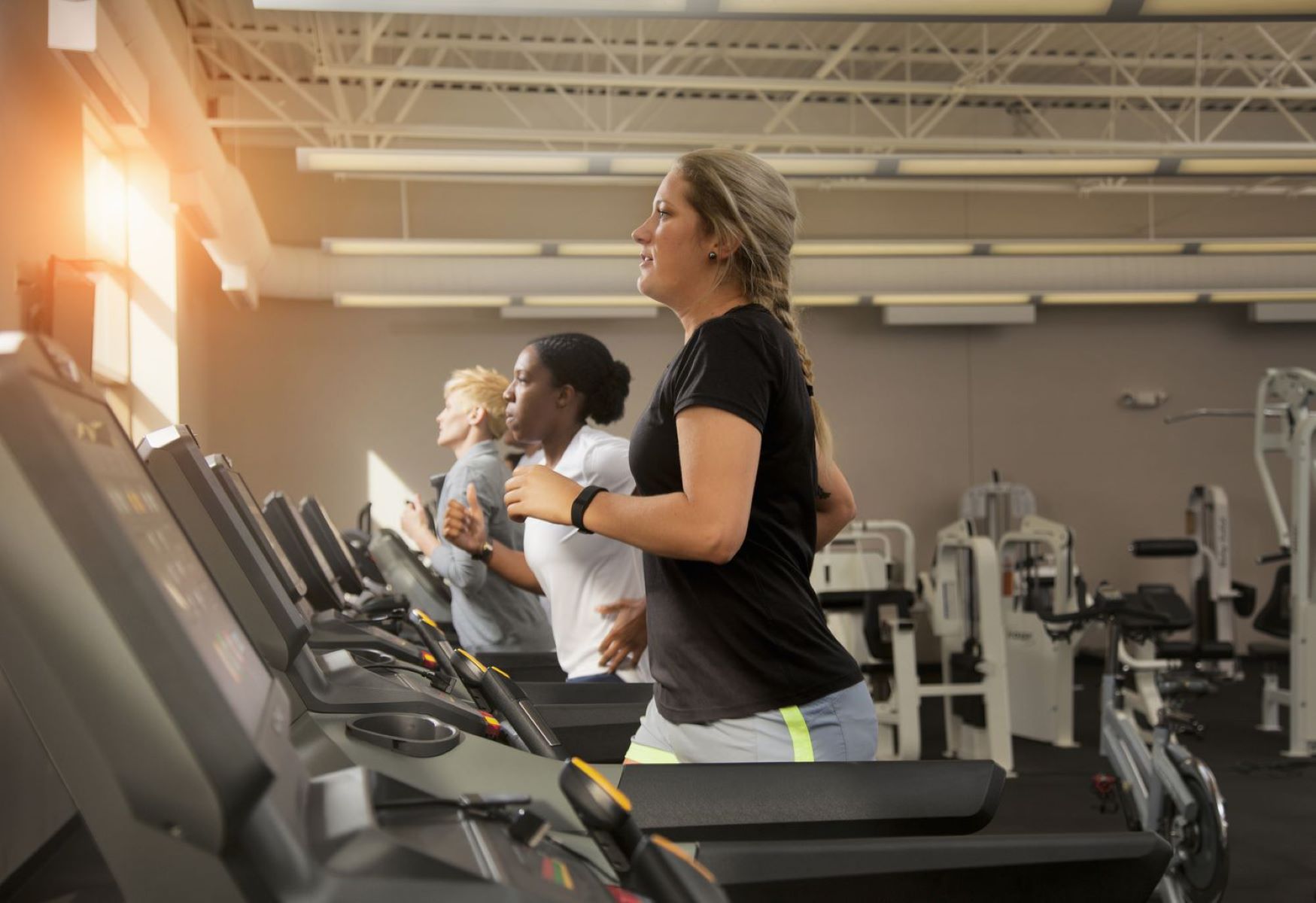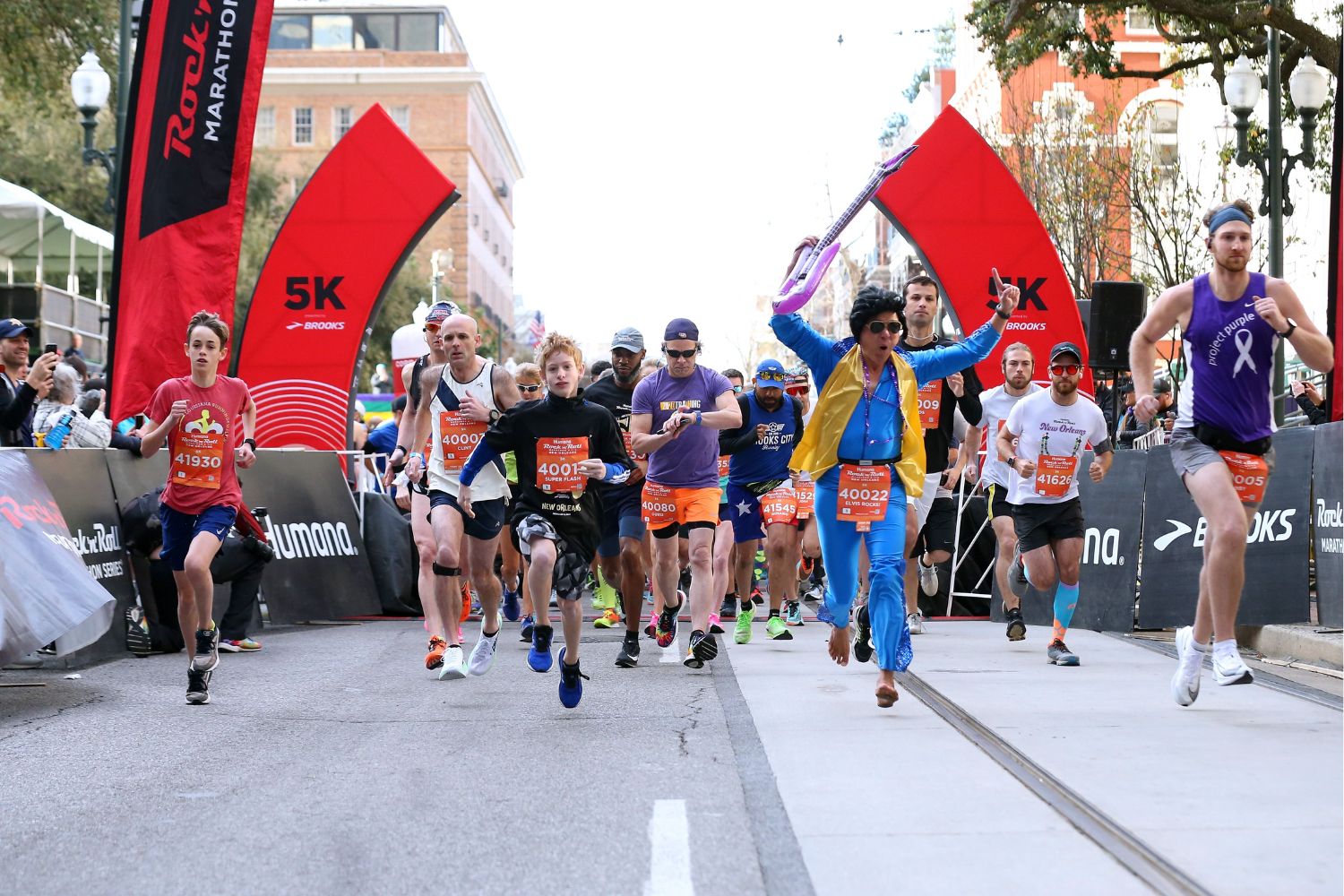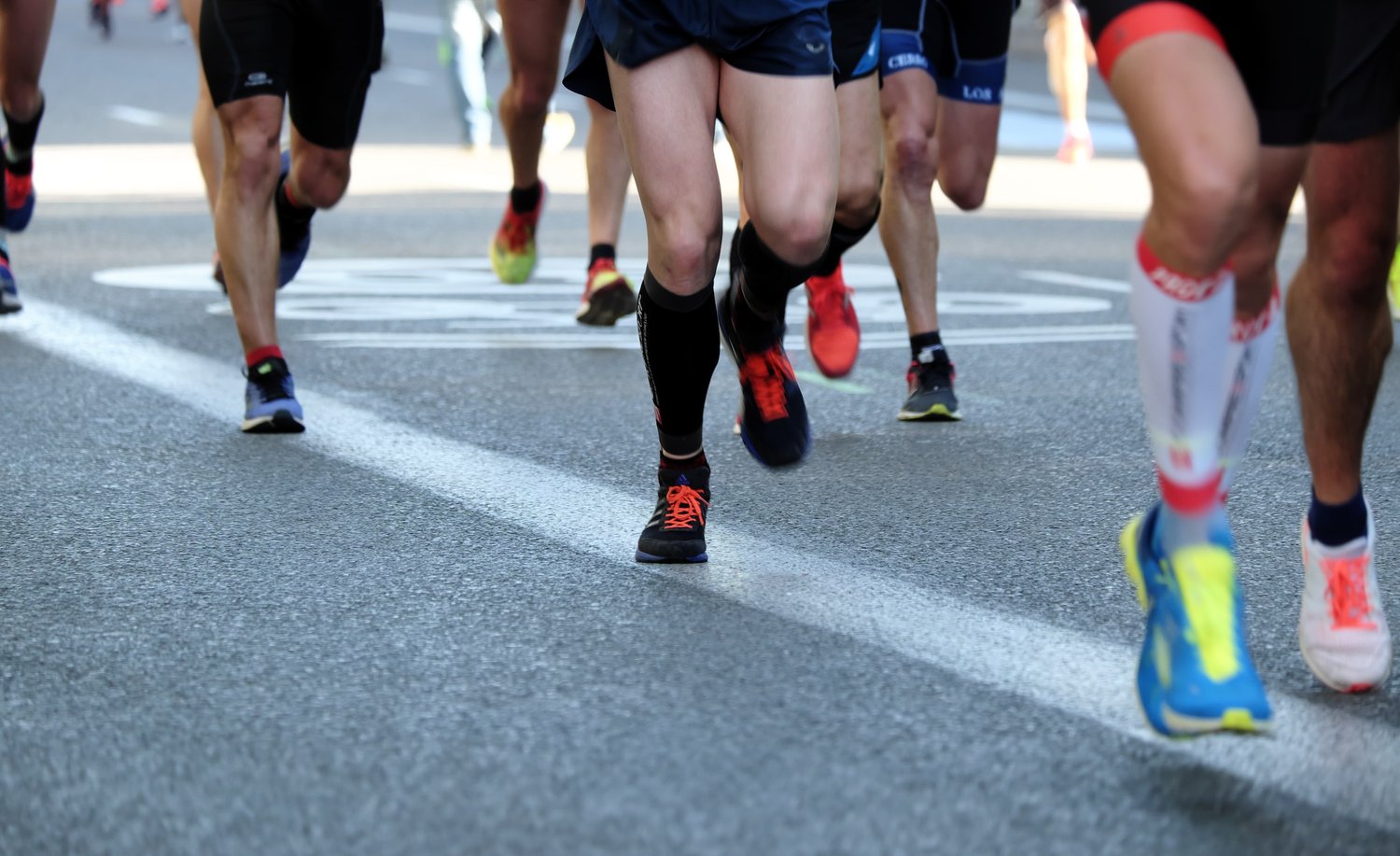

Featured
How Do You Set Up A 5K Run
Published: August 12, 2023
Learn how to set up a featured 5K run and make it a success with our comprehensive guide. Find tips and steps to organize your event efficiently and attract participants.
Introduction
Welcome to the exciting world of organizing a 5K run! Whether you are a running enthusiast, a charity organization, or a community group looking to bring people together, a 5K run is an excellent way to promote fitness, raise funds, and foster a sense of community. This article will guide you through the process of setting up and managing a successful 5K run event.
A 5K run, also referred to as a 5-kilometer race, is a popular distance in the running community. It offers participants of all fitness levels the opportunity to challenge themselves and enjoy the sense of achievement that comes with completing a race. As an organizer, your role is crucial in creating an enjoyable and memorable experience for the runners, ensuring their safety, and maximizing the impact of the event.
Planning and executing a 5K run requires careful consideration of various factors, including choosing a suitable location, obtaining permits and permissions, planning the route, ensuring safety measures, marketing and promotions, registration process, timing and results, supplies and equipment, participant communication, awards and prizes, post-race activities, and evaluating and improving future events.
In this article, we will walk you through each step of the process, providing valuable insights and practical tips to help you organize a successful 5K run from start to finish. Whether it’s your first time or you’re a seasoned event organizer, this guide will equip you with the knowledge and tools necessary to create an unforgettable experience for participants and achieve your event goals.
So, let’s dive in and explore the exciting journey of setting up a 5K run!
Choosing a Location
When it comes to organizing a 5K run, the choice of location plays a vital role in the success of your event. The right location can attract more participants, provide a scenic and enjoyable race course, and offer logistical convenience. Here are some factors to consider when selecting a location for your 5K run:
- Accessibility: Choose a location that is easily accessible to participants, whether it’s a local park, a college campus, or a downtown area. Consider proximity to public transportation, parking availability, and accessibility for individuals with disabilities.
- Scenic Route: Look for a location that offers a visually appealing route for the runners. A picturesque park, a waterfront area, or a scenic trail can enhance the overall experience and attract more participants.
- Safety: Prioritize the safety of the participants by selecting a location with low vehicular traffic and well-maintained paths. Avoid routes with challenging terrain or obstacles that may pose a risk to runners.
- Capacity: Assess the capacity of the chosen location to accommodate the expected number of participants. Consider factors such as parking space, restrooms, and the ability to set up registration and event booths.
- Permit Requirements: Research any permit requirements or restrictions associated with the chosen location. Contact the relevant authorities or park management to obtain the necessary permits and permissions for hosting the event.
- Amenities: Consider the amenities available at the location, such as water fountains, restrooms, and sheltered areas. Access to these facilities will enhance the overall comfort and convenience for participants.
- Community Support: Look for a location that has a supportive community who can volunteer, provide local sponsorship, and help with marketing and promoting the event.
By considering these factors, you can narrow down your options and select the ideal location for your 5K run. Remember, the location sets the stage for the entire event, so choose wisely to create a memorable and enjoyable experience for all participants.
Obtaining Permits and Permissions
Obtaining the necessary permits and permissions is an essential step in the process of organizing a 5K run. Depending on the location and the regulations in your area, you may need to obtain permits from local authorities, park management, and other relevant organizations. Here are some key points to consider when obtaining permits and permissions:
- Research Local Regulations: Familiarize yourself with the local regulations regarding hosting outdoor events, races, or gatherings. Contact the appropriate authorities, such as the city or county government, to understand the permits and permissions required for organizing a 5K run in your chosen location.
- Timing: Start the permit application process well in advance to allow for any processing time. Some permits may have specific deadlines or requirements, so plan accordingly to avoid any last-minute complications.
- Fill Out Application Forms: Obtain the necessary application forms from the issuing authority and fill them out accurately and completely. Provide all the required information, including event details, route maps, anticipated number of participants, and safety measures.
- Insurance: Check if insurance coverage is required for the event. In some cases, you may need to provide proof of liability insurance to protect both the organizers and participants.
- Route Approval: If your event involves utilizing public roads, seek approval from the local transportation department or police to ensure the safety of participants and minimal disruption to traffic. Submit detailed route maps and any required traffic management plans.
- Environmental Considerations: If your event takes place in a natural or protected area, make sure to comply with any environmental restrictions or guidelines. Take steps to minimize the impact on the surroundings and ensure proper waste management.
- Communication: Maintain open and clear communication with the permitting authorities throughout the process. Address any questions or concerns promptly and professionally to facilitate a smooth permit application process.
Remember, each location and jurisdiction may have unique requirements, so it’s crucial to do thorough research and follow the specific guidelines provided by the issuing authorities. Obtaining the necessary permits and permissions will ensure that your 5K run is legal, safe, and compliant with local regulations.
Planning the Route
One of the key elements in organizing a successful 5K run is designing a well-planned and engaging route for participants. A carefully selected route can enhance the overall experience, provide a challenge for runners, showcase the scenic beauty of the area, and ensure the safety of participants. Here are some considerations when planning the route for your 5K run:
- Distance: Ensure that the route is accurately measured and meets the standard distance of 5 kilometers (or 3.1 miles). Use GPS tracking devices or consult with experienced runners to verify the distance.
- Scenic Appeal: Look for a route that showcases the natural beauty or iconic landmarks of the area. Consider parks, waterfronts, historical sites, or other visually appealing locations that will make the run more enjoyable for participants.
- Accessibility: Plan a route that is easily accessible for participants of all abilities. Avoid steep inclines, difficult terrain, or areas with limited visibility.
- Safety: Ensure the route is safe for runners and properly marked. Take into consideration vehicular traffic, road crossings, and potential hazards. Consult with local law enforcement or transportation authorities to establish any necessary traffic control or safety measures.
- Course Certifications: If you want participants to be eligible for official records or rankings, consider seeking course certification from a recognized running organization. This process involves accurately measuring the route and adhering to specific guidelines.
- Water Stations: Plan the placement of water stations along the route, especially during warmer months or in areas with limited access to water. Ensure that they are easily identifiable, well-stocked, and staffed by volunteers.
- Restrooms: Take into account the availability of restrooms along the route or near the starting/finishing area. Ensure participants have easy access to facilities before and after the race.
- Spectator Areas: Identify areas along the route where spectators can gather to cheer on the participants. This can create a supportive and energetic atmosphere for runners.
- Signage and Markings: Use clear signage, mile markers, and directional arrows to guide participants along the route. Consider using temporary markings on roads or trails to avoid confusion.
- Route Preview: Walk or run the entire route beforehand to identify any potential issues or areas that may need attention. This will allow you to make necessary adjustments and ensure a smooth race day experience.
By taking these factors into account, you can plan a route that offers both a challenging and enjoyable experience for participants. Remember to prioritize safety, showcase the area’s beauty, and create an engaging route that will leave the runners with lasting memories.
Safety Measures and Medical Support
Ensuring the safety of participants is of utmost importance when organizing a 5K run. Implementing proper safety measures and having medical support in place can help prevent accidents, address emergencies promptly, and provide peace of mind to both participants and organizers. Here are some essential safety considerations for your event:
- Risk Assessment: Conduct a thorough risk assessment of the event venue and route. Identify potential hazards such as uneven terrain, road crossings, or areas with limited visibility. Take necessary steps to mitigate these risks and ensure a safe race environment.
- Medical Team: Arrange for medical personnel to be present throughout the event. Depending on the scale of the run, this could include first aid responders, EMTs, or even a dedicated medical tent. Ensure all medical team members are properly trained and certified.
- Emergency Communication: Establish a clear communication plan in case of emergencies. Provide all volunteers and staff with a designated point of contact for reporting incidents or injuries. Have a reliable means of communication, such as two-way radios or cell phones, to quickly relay information to medical personnel or emergency services if needed.
- Safety Briefing: Conduct a pre-race safety briefing for participants, highlighting important information such as potential hazards along the route, medical aid locations, and emergency procedures. Emphasize the importance of staying aware, following course markings, and looking out for fellow runners.
- Course Marshals: Station volunteers or course marshals along the route to provide guidance, offer assistance, and monitor participant safety. Make sure they are easily identifiable in case runners need to seek help during the event.
- Hydration and Nutrition: Ensure an adequate number of water stations along the route, especially during warmer months or in challenging weather conditions. Instruct volunteers on proper water distribution and encourage participants to hydrate before, during, and after the race.
- Participant Sign-In/Out: Implement a sign-in and sign-out process for participants to track their presence on the course. This will help identify any missing participants and expedite response efforts in case of an emergency.
- Weather Monitoring: Stay informed about the weather conditions leading up to and during the event. Make contingency plans in case of extreme weather, such as lightning storms or excessive heat, to ensure participant safety.
- Insurance: Consider obtaining event liability insurance to protect the organizers and participants in case of accidents or injuries. Consult with an insurance professional to determine the appropriate coverage for your event.
- Post-Race Evaluation: After the event, evaluate the effectiveness of the safety measures and medical support provided. Gather feedback from participants, volunteers, and medical personnel to identify areas of improvement for future events.
By prioritizing safety and having appropriate measures in place, you can create a secure and enjoyable environment for all participants. Remember, the safety and well-being of everyone involved should always be the top priority when organizing a 5K run.
Marketing and Promotions
Effective marketing and promotions are essential components in ensuring the success of your 5K run. By effectively spreading the word about your event, you can attract a larger number of participants, increase community engagement, and generate excitement. Here are some key strategies to consider when marketing and promoting your 5K run:
- Create a Website or Landing Page: Establish an online presence for your event by creating a dedicated website or landing page. Include key information such as event details, registration process, route map, and FAQs. Make sure the website is mobile-friendly and easy to navigate.
- Social Media: Utilize social media platforms to promote your 5K run. Create event pages on popular platforms such as Facebook, Instagram, and Twitter. Regularly share updates, engaging content, and photos of past events to build excitement and encourage participation.
- Local Media: Contact local newspapers, radio stations, and television stations to inform them about your event. Submit press releases or pitch story ideas to generate media coverage. Engage with local bloggers or influencers who may be interested in promoting your event to their audience.
- Collaborate with Partners: Seek partnerships with local businesses, fitness centers, schools, or community organizations. They can help promote your event to their networks, provide sponsorships, or assist with logistical support.
- Flyers and Posters: Create eye-catching flyers and posters to distribute in high-traffic areas, community centers, gyms, and local businesses. Include essential event information and contact details.
- Email Marketing: Build an email list of past participants, potential runners, and community members who may be interested in the event. Send regular newsletters with updates, registration reminders, and special offers to keep them engaged.
- Influencer Marketing: Collaborate with local fitness influencers or running clubs who can endorse your event to their followers. Offer them complimentary registrations or exclusive discounts to encourage their participation and promotion.
- Word of Mouth: Encourage participants, volunteers, and supporters to spread the word about your event to their friends, family, and colleagues. Offer incentives, such as referral discounts or free merchandise, for those who successfully refer new participants.
- Engage with the Community: Participate in local events, health fairs, or running expos to raise awareness about your 5K run. Set up a booth, distribute promotional materials, and engage in conversations to generate interest and registrations.
- Charity Partnership: If your event supports a specific cause or charity, highlight the charitable aspect in your marketing efforts. Build partnerships with relevant organizations and leverage their network to promote both the event and the cause.
Remember, effective marketing and promotions require consistency and creativity. Utilize a mix of online and offline strategies to reach a wider audience and maximize participant engagement. By creating a buzz around your event, you can attract more participants and generate enthusiasm for your 5K run.
Volunteer Recruitment and Training
Volunteers are a crucial part of any successful 5K run event. They provide invaluable support, contribute to the smooth operation of the event, and enhance the overall participant experience. Recruiting and training volunteers is essential to ensure that everyone is well-prepared and equipped to fulfill their roles effectively. Here are some key points to consider when recruiting and training volunteers for your 5K run:
- Identify Volunteer Needs: Determine the number and types of volunteers needed for various tasks, such as registration, course marshaling, water stations, start/finish line support, and first aid.
- Recruitment Strategies: Create a clear volunteer recruitment plan. Leverage your event website, social media platforms, local community groups, and schools to spread the word and encourage volunteer sign-ups. Clearly outline the roles and expectations to attract individuals with the necessary skills and interests.
- Orientation and Training: Organize an orientation session for all volunteers to familiarize them with the event details, their roles, and responsibilities. Provide a handbook or manual with important information, including contact details, event schedules, emergency procedures, and any specific instructions related to their tasks.
- Skills Assessment: Identify the skills and experience required for specific volunteer roles. Ask volunteers to provide information about their previous experience, relevant certifications, or specific skills that may be beneficial for their assigned tasks.
- Communication Channels: Establish clear communication channels with volunteers to provide updates, answer questions, and address any concerns. Utilize email, messaging apps, or volunteer management platforms to ensure effective communication before, during, and after the race.
- Training Opportunities: Offer training sessions or workshops to equip volunteers with the necessary skills and knowledge for their roles. Topics may include first aid basics, course marshaling guidelines, customer service techniques, and effective communication strategies.
- Recognition and Appreciation: Show appreciation to your volunteers for their time and effort. Recognize their contributions through thank-you notes, certificates, volunteer appreciation events, or small tokens of gratitude. This will help build a sense of pride and encourage continued volunteer support for future events.
- Delegate Responsibilities: Assign specific roles and responsibilities to volunteers based on their skills, interests, and availability. Clearly communicate expectations and provide any necessary training materials or resources.
- Volunteer Support: Ensure that volunteers have access to necessary resources such as water, food, and rest areas during their shifts. Regularly check in with them to address any concerns and provide guidance as needed.
- Post-Event Feedback: Gather feedback from volunteers after the event to assess their experiences and suggestions for improvement. Use this feedback to enhance the volunteer program for future events.
Remember, volunteers are the backbone of your 5K run event. Their dedication and support play a crucial role in its success. By recruiting and training volunteers effectively, you can ensure a well-run and enjoyable event for all participants.
Registration Process
The registration process is a vital aspect of organizing a 5K run event. It is important to have a streamlined and user-friendly registration system that allows participants to easily sign up for the event and provides organizers with the necessary information. Here are key points to consider when developing the registration process for your 5K run:
- Online Registration: Provide an online registration option through your event website or a dedicated registration platform. This allows participants to sign up conveniently from anywhere at any time. Ensure that the registration form is clear, concise, and mobile-friendly.
- Registration Fee: Determine the registration fee for participants, keeping in mind any associated costs such as permits, timing systems, or event materials. Consider offering early-bird discounts or special rates for groups or teams to encourage early sign-ups.
- Key Information: Collect essential participant information during the registration process, including name, contact details, emergency contact information, age, gender, and any other relevant details specific to your event (e.g., t-shirt size or waiver agreement).
- Event Waiver: Include a clear and concise event waiver in the registration process that participants must read and agree to. Clearly outline any risks, release of liability clauses, and the participants’ responsibilities during the event.
- Payment Options: Provide multiple payment options to accommodate participants’ preferences. Accept credit/debit cards, PayPal, and other secure online payment methods. Consider offering offline payment options, such as check or cash, for those who prefer non-electronic payment methods.
- Confirmation and Receipts: Send an automatic confirmation email to participants upon successful registration. Include important details such as the event date, time, location, and any additional information they may need to know. Provide receipts for registration fees and include a contact person in case of any registration-related inquiries.
- Cancellation and Refunds: Clearly communicate your event’s cancellation and refund policy. Specify any deadlines and fees associated with cancellations or participant withdrawals.
- Race Capacity: Establish a maximum limit on the number of participants your event can accommodate. Monitor registration numbers closely to prevent overbooking and ensure a safe participant experience.
- Waitlist: If your event reaches capacity, offer participants the option to join a waitlist. Notify waitlisted participants if spots become available, based on the order of their registration on the waitlist.
- Participant Communication: Develop a communication plan to keep participants informed leading up to the event. Send pre-event emails with important updates, instructions, and any last-minute reminders.
By implementing an efficient and user-friendly registration process, you can ensure a smooth experience for participants and efficiently manage the registration details for your 5K run. This will help streamline event operations and allow organizers to focus on other key aspects of the event’s success.
Timing and Results
Precise timing and accurate result reporting are critical components of a well-organized and professional 5K run. Participants rely on timing systems to track their performance, compare results, and gauge their progress. Here are important considerations for timing and result management:
- Timing Method: Choose a reliable timing method that suits the scale and budget of your event. Options include manual timing, disposable chip timing, or electronic chip timing. Each method has its advantages and should be selected based on the needs and resources of your event.
- Timing Equipment: If using electronic or disposable chip timing, ensure you have the necessary equipment, including timing mats, bibs or chips, antennas, and a finish line camera (if applicable). Test the equipment before the event to identify any issues or potential areas for improvement.
- Start and Finish Line Setup: Set up clear start and finish lines with visible timing clocks or displays. Clearly mark the starting line to guide participants to the correct location. Install timing mats or checkpoints to capture accurate race times.
- Backup Systems: Have backup timing systems in place to mitigate any technical failures or discrepancies. This may include manual timing or redundant electronic timing systems.
- Timing Mat Placement: Position timing mats strategically to capture accurate start, lap, and finish times. Consult with timing professionals or experienced race organizers to determine optimal mat placement.
- Result Availability: Aim to provide immediate or near-immediate access to participant results. Consider using a timing system that offers real-time result updates, either through a website, mobile app, or on-site display boards. Ensure that results are easily searchable by bib number or participant name.
- Award Categories: Define award categories based on age groups, gender, or other criteria that align with your event’s goals. Clearly communicate these categories to participants before the event, and ensure results are calculated accordingly.
- Results Disputes: Establish a process for handling results disputes or errors. Designate a point of contact or a results hotline where participants can report any concerns or discrepancies.
- Awards Ceremony: Plan and execute an awards ceremony to recognize top finishers in each category. Ensure prizes or medals are prepared in advance and consider involving sponsors or local dignitaries to present awards.
- Result Publication: Publish official race results on your event website or through other communication channels. Share results on social media and notify participants via email to ensure they are aware of their official finishing times.
- Timing Evaluation: Evaluate the timing process and participant feedback after the event. Analyze any issues or areas for improvement and make necessary adjustments for future events.
By implementing effective timing and result management, you can enhance the overall participant experience, provide accurate and timely results, and solidify the reputation of your 5K run as a well-organized event.
Supplies and Equipment
Having the right supplies and equipment is essential for the smooth operation of your 5K run. From registration materials to race day essentials, proper planning and preparation will ensure that you have everything you need to support participants and create a memorable event. Here are some key considerations when it comes to supplies and equipment:
- Bib Numbers: Provide participants with bib numbers that include their unique identification and timing chip (if applicable). Ensure that bibs are of high quality, waterproof, and securely attachable.
- Timing System: Depending on your budget and event scale, choose the appropriate timing system. This may include timing mats, RFID chips, or electronic timing devices. Test the timing equipment before the event to ensure accuracy and reliability.
- Registration Materials: Prepare registration packets containing essential items such as bib numbers, safety pins, event t-shirts (if provided), waivers, and any promotional materials or vouchers.
- Start/Finish Line Equipment: Set up a sturdy start and finish line structure, including arches, banners, or inflatable markers. Ensure that the start and finish lines are clearly marked and visible to participants.
- Course Signage: Place directional signs along the route to guide participants. Use large, clear, and easy-to-read signage to prevent any confusion or wrong turns.
- Water Stations: Arrange tables, cups, and water containers for the water stations along the course. Ensure an adequate supply of water and have volunteers trained to distribute water efficiently to participants.
- First Aid Kits: Have fully stocked first aid kits readily available at various points along the race route, as well as at the start and finish lines. Ensure that volunteers and medical personnel are trained to handle common race-related injuries.
- Volunteer Supplies: Provide volunteers with necessary supplies such as radios, clipboards, pens, maps, and any other materials specific to their assigned tasks.
- Registration and Timing Software: Utilize online registration and timing software to streamline the registration process and manage participant information. Choose a reliable and user-friendly platform that meets the needs of your event.
- Event Tents and Tables: Set up tents or canopies at the start and finish area to provide shade and shelter for organizers, volunteers, and participants. Arrange tables or booths for registration, information, and other event-related activities.
- Public Address System: Ensure you have a clear and functional public address system to make important announcements and provide instructions to participants, volunteers, and spectators throughout the event.
- Race Course Supplies: Consider additional supplies such as mile markers, timing clocks, course markers, cones, tape, and barriers to clearly demarcate the race course and ensure participant safety.
- Storage and Transportation: Arrange for proper storage and transportation of all event supplies and equipment. Use labeled bins or boxes to keep everything organized and easily accessible.
By ensuring that you have the necessary supplies and equipment well in advance, you can create a well-organized and professional 5K run event. Proper preparation will enable you to provide a smooth and enjoyable experience for participants, volunteers, and spectators on race day.
Water Stations and Refreshments
Proper hydration and nourishment are essential for participants during a 5K run to perform at their best and stay safe. Planning well-thought-out water stations and providing refreshments along the route and at the finish line can greatly enhance the overall participant experience. Here are some key considerations when it comes to water stations and refreshments:
- Water Station Placement: Strategically position water stations along the race route at regular intervals, taking into account the distance between stations and the weather conditions on the event day. Place stations in visible, easily accessible areas.
- Volunteer Support: Ensure that each water station is staffed with dedicated volunteers who are responsible for setting up and restocking water, distributing cups, and guiding participants to avoid congestion.
- Water Supply: Arrange for an adequate supply of potable water at each station. Consider using large coolers, water dispensers, or water jugs to ensure a continuous flow of water for participants.
- Alternative Hydration Options: Consider offering electrolyte drinks or sports beverages at one or more water stations to replenish participants’ electrolytes and enhance their performance.
- Communicate Water Station Locations: Clearly communicate the locations of water stations to participants in advance. Include this information on the event website, in pre-race communications, and in the event program to ensure participants are aware and can plan their hydration strategy accordingly.
- Disposable Cups: Use environmentally friendly, disposable cups for water distribution. Make sure cups are easily recyclable and provide ample quantities to avoid running out during the event.
- Waste Management: Set up designated waste disposal stations near each water station and clearly communicate the importance of proper waste management to participants and volunteers.
- Post-Race Refreshments: Plan to provide refreshments for participants at the finish line. Consider offering a variety of options, including fruit, energy bars, granola, or even a light breakfast for participants to replenish their energy stores.
- Dietary Restrictions: Take into account participants with specific dietary restrictions or allergies when selecting post-race refreshments. Offer alternatives or clearly indicate the ingredients to ensure all participants can safely enjoy the post-run refreshments.
- Vendor Collaboration: Partner with local businesses or food vendors who can provide post-race refreshments or sponsor the water stations. This can help reduce costs and provide additional options for participants.
- Consider Environmental Sustainability: Use recyclable or compostable cups, plates, and utensils for post-race refreshments. Encourage participants to dispose of waste responsibly and provide separate bins for recycling and composting.
- Hydration Reminders and Education: Inform participants about the importance of hydration and provide tips on effective hydration strategies leading up to and during the event. Include this information on your event website, in pre-race communications, and at the water stations.
By carefully planning and organizing water stations and refreshments, you can ensure that participants stay hydrated and energized throughout the event. Providing ample hydration options and post-race refreshments will contribute to a positive participant experience and help them recover and celebrate their accomplishments at the finish line.
Race Day Logistics
Race day logistics are crucial for the smooth and efficient execution of your 5K run event. Proper planning and organization are key to ensure that all aspects of the event, from participant check-in to course management, are well-coordinated. Here are some essential considerations for race day logistics:
- Participant Check-In: Set up a designated area for participant check-in, packet pickup, and last-minute registrations. Clearly mark the check-in location and ensure there are enough volunteers to assist with the process.
- Start Line Organization: Establish a well-organized start line area with clear signage and instructions. Assign volunteers or race officials to manage participant lineup, maintain order, and ensure a smooth and timely start for all participants.
- Wave Starts: If your event has a large number of participants, consider implementing wave starts to alleviate congestion at the start line. Group runners based on their projected finish times or other factors to stagger the start times and improve participant flow.
- Course Marshals: Assign course marshals at key points along the route to ensure participant safety, guide runners, and provide assistance when needed. Clearly communicate their roles and locations, and ensure they have the necessary equipment (e.g., flags, radios, and maps).
- Timing and Results Updates: Provide real-time or periodic timing and results updates to participants and spectators. This can be accomplished through electronic displays, a mobile app, or regular announcements from the event emcee.
- Spectator Management: Plan and communicate spectator viewing areas along the race course. Ensure the safety of both participants and spectators and provide instructions to spectators on where to cheer and how to navigate the event area.
- First Aid and Medical Support: Arrange for medical personnel, first aid stations, and a designated medical tent to provide immediate assistance in case of any injuries or medical emergencies. Communicate the location of these services to participants and volunteers.
- Event Timelines: Develop a detailed schedule for race day, including the start time, wave start times (if applicable), award ceremony, and any post-race activities. Share the timeline with participants, volunteers, and staff to ensure everyone is aware of the event flow and their responsibilities.
- Race Photography: Coordinate with professional photographers or volunteer photographers to capture memorable moments of the event. Communicate photo locations to participants and provide instructions on how to access the event photos afterwards.
- Event Transportation: Communicate transportation information to participants, including parking locations, public transportation options, and any shuttle services provided. Ensure there is adequate parking capacity and that transportation options are clearly marked.
- Lost and Found: Designate a lost and found area where participants can inquire about or retrieve any lost items. Clearly communicate the location and process for lost and found items to minimize confusion and facilitate item recovery.
- Volunteer Coordination: Assign volunteer captains or team leaders to oversee various areas of race day logistics, such as participant check-in, course management, and refreshment stations. Ensure that volunteers have clear instructions, know their roles, and have the necessary materials and support to fulfill their responsibilities.
By meticulously planning and managing race day logistics, you can create a well-organized and enjoyable experience for participants, spectators, and volunteers alike. Effective logistics ensure a safe, efficient, and memorable event that reflects positively on your 5K run and encourages future participation.
Participant Communication
Clear and consistent communication with participants is vital to ensure that they have all the necessary information for a successful and enjoyable 5K run experience. Effective participant communication helps build excitement, provides important event details, and assists in managing expectations. Here are key considerations for participant communication:
- Pre-Event Communications: Establish regular communication channels with participants leading up to the event. Send out informational emails, newsletters, or notifications through your event website or registration platform. Include important details such as race day instructions, parking information, start times, and any last-minute updates.
- Event Website: Maintain an updated event website with all relevant information, including registration details, course maps, FAQs, and important updates. Ensure the website is mobile-friendly and easily accessible for participants to find the information they need.
- Participant Guide: Create a participant guide that provides comprehensive information about the event. Include details on registration, packet pickup, parking, race rules, equipment requirements, course description, aid stations, and post-race activities. Distribute the guide digitally or in printed format.
- Pre-Race Briefings: Conduct pre-race meetings or briefings where participants can ask questions, clarify any doubts, and receive important updates or instructions. Ensure that key information is reiterated and communicated clearly to all participants.
- Social Media Engagement: Utilize social media platforms to engage with participants and answer their questions in a timely manner. Regularly post updates, reminders, training tips, and motivational content to build excitement and encourage participant interaction.
- Online Community: Establish a dedicated online community or forum where participants can connect with each other, share training experiences, and ask event-related questions. Encourage participants to support and motivate one another, creating a sense of community around the event.
- Race Day Information: Provide participants with a race day information packet or email that includes final instructions, event timelines, start line procedures, parking details, and any changes or updates specific to race day logistics.
- Post-Race Communication: Follow up with participants after the event to express appreciation, share official results, and provide any post-event information. Send out thank-you emails or newsletters that include links to event photos, surveys, and future event announcements.
- Communication Volunteers: Assign volunteers or staff members to be available throughout the event to answer participant questions, provide assistance, and offer support. Clearly distinguish them with identifiable clothing or badges.
- Emergency Communication: Establish a clear emergency communication plan and provide participants with the emergency contact information they need to ensure their safety. Clearly communicate evacuation routes, first aid locations, and procedures for reporting emergencies or seeking assistance.
By prioritizing participant communication, you can ensure that participants have a positive experience leading up to and during the 5K run event. Effective communication builds trust, addresses concerns, and fosters a sense of community, resulting in a memorable and satisfying experience for all participants.
Awards and Prizes
Awards and prizes add excitement and motivation to a 5K run event, celebrating participants’ achievements and recognizing their hard work. Well-planned awards and prizes can enhance the overall participant experience and encourage future participation. Here are key considerations when it comes to awards and prizes:
- Award Categories: Determine the award categories for your 5K run event. Common categories include overall male and female winners, age group winners, and team or corporate challenge winners. Consider the demographics of your participants and the goals of your event when selecting award categories.
- Prizes: Determine the prizes for each award category. Prizes can range from trophies or medals to merchandise, gift certificates, or vouchers. Seek sponsorships from local businesses to provide prizes or consider partnering with companies that align with your event’s mission or cause.
- Award Presentation: Plan and execute an awards ceremony following the race. Ensure that the ceremony is well-organized and allows for the recognition of winners, including time for photos and applause. Consider involving sponsors, volunteers, or local dignitaries to present the awards.
- Award Timing: Communicate when and where the awards ceremony will take place to ensure that winners and participants are aware of the timing and can attend. If unable to attend, provide alternative arrangements for winners to receive their awards.
- Age Group Categories: Divide participants into age groups, typically in five or ten-year increments, to acknowledge winners in each category. This allows participants to compete against others within their age range, maintaining a fair and inclusive competition.
- Team or Corporate Challenge: Offer a team or corporate challenge category to promote friendly competition among groups. Recognize the team with the fastest combined time or the largest team participation.
- Timing and Results Verification: Ensure that the timing and results are accurate and verified before declaring winners. Employ reliable timing systems and have a robust results verification process in place to minimize errors or disputes.
- Celebrating Every Participant: Consider providing all participants with finisher medals or certificates as a token of appreciation for their participation and effort. This helps create a positive experience for all participants, regardless of their finishing time.
- Prize Drawings or Raffles: Consider organizing prize drawings or raffles to involve all participants in the prize-winning experience, even if they did not place in the top rankings. This adds an element of excitement and rewards participants for their support.
- Post-Race Recognition: Acknowledge winners and share event results through social media, event websites, or local publications. Highlight outstanding achievements and share participant testimonials to celebrate the success of participants and encourage future participation.
By carefully planning and executing awards and prizes, you can create a rewarding and celebratory atmosphere for participants, recognizing their accomplishments and encouraging them to strive for further success. Well-deserved recognition contributes to the overall satisfaction and motivation of participants in your 5K run event.
Post-Race Activities
The excitement and sense of achievement continue even after participants have crossed the finish line in a 5K run event. Engaging post-race activities can create a memorable experience and foster a sense of community among participants. Here are some key considerations when planning post-race activities:
- Finish Line Celebration: Create a vibrant atmosphere at the finish line with music, cheering volunteers, and spectators. Encourage participants to celebrate their accomplishment as they cross the finish line, and provide an area for them to gather, rest, and reunite with friends and family.
- Post-Race Food and Beverages: Offer a variety of refreshments and snacks for participants to refuel and replenish their energy levels. Consider providing a mix of healthy and indulgent options, catering to different dietary preferences and restrictions.
- Entertainment: Arrange for post-race entertainment, such as live music, a DJ, or cultural performances, to keep participants engaged and create a celebratory atmosphere. This adds an element of fun and enjoyment for both participants and spectators.
- Vendor Booths: Invite local vendors, businesses, or sponsors to set up booths or tents to showcase their products or services. This can add a festive element and provide participants with the opportunity to connect with relevant organizations.
- Children’s Activities: Plan age-appropriate activities or a designated area for children to enjoy after the run. Consider face painting, bounce houses, or games to keep young ones entertained while parents relax or engage in post-race activities.
- Awards Ceremony: Conduct an awards ceremony to recognize winners in various categories, as well as any special achievements. Make the ceremony engaging and celebratory, and involve sponsors or local dignitaries to present the awards.
- Participant Photographs: Set up photo booths or designated areas for participants to capture memories of their accomplishment. Partner with professional photographers or volunteer photographers to offer free or discounted photo opportunities.
- Massage and Recovery Services: Arrange for post-race massage therapists or physical therapists to offer participants relaxation and recovery services. This can include post-race stretching, massages, or even structured cool-down activities.
- Charitable Engagement: Showcase any charitable initiatives or fundraising efforts associated with the event. Acknowledge and celebrate the impact made by participants, sponsors, and supporters in contributing to the cause.
- Evaluation and Feedback: Provide participants with the opportunity to provide feedback on their experience through surveys, online forms, or suggestion boxes. Gather insights to improve future events and express gratitude for their input and participation.
- Volunteer Appreciation: Express appreciation towards volunteers and sponsors who supported the event. Consider organizing a separate appreciation event or sending thank-you notes to recognize their contributions and build long-term partnerships.
By offering engaging and inclusive post-race activities, you can create a memorable experience for participants, keep them engaged, and foster a sense of community. The post-race activities further enhance the overall value and enjoyment of the 5K run event.
Evaluating and Improving Future Events
Evaluating the success of your 5K run event is a crucial step in the event planning process. Reflecting on the strengths and areas for improvement allows you to make informed decisions and enhance future events. Here are key considerations for evaluating and improving future events:
- Participant Feedback: Gather feedback from participants through post-event surveys or online forms. Ask for input on various aspects of the event, including registration process, communication, course design, refreshments, entertainment, and overall participant experience.
- Volunteer and Staff Input: Seek feedback from volunteers and event staff. They play a crucial role in event execution and can provide valuable insights and suggestions for improvement.
- Timing and Results Review: Assess the accuracy and reliability of the timing and results system. Review any timing discrepancies or issues and identify areas for improvement in future events.
- Sponsor and Partner Evaluation: Collect feedback from sponsors and partners to assess their experience and gauge the value they received from their involvement. Use their insights to strengthen future partnerships and improve sponsor offerings.
- Budget Analysis: Conduct a thorough analysis of the event budget to identify areas of cost-saving or potential revenue enhancement. Consider ways to optimize expenses without compromising the quality and experience of the event.
- Logistic Review: Evaluate the logistical aspects of the event, such as participant check-in, course management, water stations, and volunteer coordination. Identify any areas that experienced challenges and devise strategies to overcome them in future events.
- Participant Numbers: Analyze participant registration and attendance numbers to understand trends and make informed decisions regarding marketing efforts, registration fees, and participant engagement strategies.
- Vendor and Exhibitor Feedback: Seek feedback from vendors and exhibitors regarding their experience at the event. Understand their perspective on participant engagement, setup logistics, and overall value received as part of their involvement.
- Action Planning: Use the feedback and insights gathered to develop an action plan for future events. Outline specific areas of improvement, prioritize them based on importance and feasibility, and assign responsible parties and timelines for implementation.
- Continuous Improvement: Embrace a culture of continuous improvement by regularly analyzing event outcomes and seeking new ideas. Stay updated on industry trends, attend workshops or conferences, and network with other event organizers to learn from their experiences.
- Documenting Lessons Learned: Keep records of lessons learned, improvements made, and challenges faced during each event. This documentation will serve as a valuable resource for future event planning and provide guidance in overcoming similar challenges.
By evaluating and incorporating feedback into future events, you can continuously improve the participant experience and ensure the long-term success of your 5K run. The commitment to evaluation and improvement demonstrates your dedication to providing a high-quality event and keeps participants engaged and excited to participate in future editions.
Conclusion
Organizing a 5K run requires careful planning, attention to detail, and a commitment to creating an exceptional experience for participants. From choosing the right location to evaluating and improving future events, each step of the process contributes to a successful and memorable event.
By considering factors such as location accessibility, scenic routes, safety measures, effective marketing, and engagement with participants, you can lay the foundation for a well-organized event. Obtaining permits and permissions, planning the route, and ensuring proper timing and result management are key logistical elements to execute flawlessly.
Engaging volunteers, streamlining the registration process, and providing adequate water stations and refreshments contribute to the participant experience. Clear and consistent communication, both before and after the event, helps build excitement, manage expectations, and foster a sense of community.
Recognizing participants through awards and prizes, and arranging post-race activities, not only celebrate their achievements but also create lasting memories and a sense of accomplishment. By evaluating each event and continuously improving upon its weaknesses, you can consistently deliver greater value to participants and stakeholders.
Organizing a 5K run is a rewarding endeavor that requires passion, dedication, and a focus on the participant experience. With careful planning, effective execution, and a commitment to improvement, your 5K run events will not only provide a platform for fitness and community engagement but also leave a lasting impact on participants and build a strong foundation for future success.

